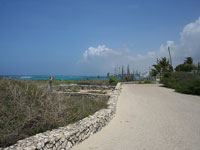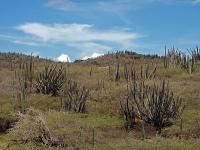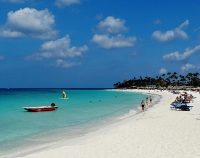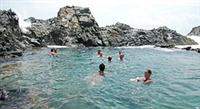Country guides

Things to do in Aruba
Windsurfing and kitesurfing are two of the biggest draws for visitors to Aruba, and there are spots suitable for all levels, along with plenty of schools and shops offering lessons and equipment rental. The island also has excellent snorkelling and diving along its coral reefs, as well as water-based activities such as tubing and banana boating in many resort areas.
Those interested in horseback riding will find Aruba's varied terrain ideal for guided excursions. Operators such as Rancho Notorious offer rides through sand dunes, along the coastline, and across desert plains. No previous riding experience is required, and many tours take in scenic views and notable landmarks around the island.
Deep-sea fishing is another popular activity, and visitors will find charter boats departing from the waterfront in Oranjestad. Visitors can book half-day or full-day trips with a captain and crew, and target a wide range of Atlantic game fish including marlin, tuna, mahi-mahi, barracuda and more. During the high season, it's advisable to book in advance.
For those who prefer a slower pace, Aruba's long stretches of white-sand beaches, clear waters and consistent sunshine provide the perfect setting for a relaxing day in the sun.

San Nicolaas
With its vibrant street art, laid-back charm, and easy access to some of Aruba's most beloved beaches, San Nicolaas is quickly becoming a favourite for travellers looking to experi…
San Nicolaas
With its vibrant street art, laid-back charm, and easy access to some of Aruba's most beloved beaches, San Nicolaas is quickly becoming a favourite for travellers looking to experience the island beyond the resort scene. Located on Aruba's southern coast, this colourful town is home to Baby Beach and Rodgers Beach, both of which are perfect for swimming, snorkelling and family-friendly relaxation. The heart of San Nicolaas features a lively promenade lined with murals, local shops, and restaurants that reflect the town's rich Afro-Caribbean heritage. Once a quiet fishing village, San Nicolaas transformed in the 20th century with the rise of phosphate mining and the establishment of a major oil refinery. Today, it's known as Aruba's industrial centre and cultural soul, offering visitors an authentic slice of island life just 30 minutes from Oranjestad.

Arikok National Park
Arikok National Park is one of Aruba's most captivating landscapes, where desert hills, towering cacti, and twisted divi-divi trees stretch toward a wild northern coast. Winding tr…
Arikok National Park
Arikok National Park is one of Aruba's most captivating landscapes, where desert hills, towering cacti, and twisted divi-divi trees stretch toward a wild northern coast. Winding trails lead visitors to ancient caves such as Fontein and Quadirikiri, where sunlight filters through openings and Arawak rock drawings whisper of the island's earliest inhabitants. Scattered ruins of gold mines and forgotten plantations hint at Aruba's layered past, while restored adobe farmhouses, known as cas di cunucu, offer a rare glimpse into traditional island life. For those craving nature, history and adventure in one place, Arikok delivers an unforgettable escape.
Website www.arubanationalpark.org

Aruba Beaches
Just north of Aruba's capital is one of the island's most celebrated beach areas, which stretches from Eagle Beach to Palm Beach and is lined with resorts, palm trees and sunshine.…
Aruba Beaches
Just north of Aruba's capital is one of the island's most celebrated beach areas, which stretches from Eagle Beach to Palm Beach and is lined with resorts, palm trees and sunshine. Palm Beach in particular is packed with luxury hotels, a wide sidewalk promenade, bars, beach clubs, and vendors offering water sports rentals such as kayaks, paddleboards, snorkelling gear, and windsurfing. To the north, beaches such as Malmok, Boca Catalina, and Arashi offer rocky reefs, colourful fish, and spots that snorkellers love. Some reefs lie just a short swim from shore, making them accessible even to casual snorkellers or families.

Natural Pool
Also known as 'Conchi' or 'Cura di Tortuga', Aruba's Natural Pool is a must-see attraction on the island's rugged north-eastern coast. This hidden gem is formed by a natural basin …
Natural Pool
Also known as 'Conchi' or 'Cura di Tortuga', Aruba's Natural Pool is a must-see attraction on the island's rugged north-eastern coast. This hidden gem is formed by a natural basin in the coastal igneous rock, and filled by waves crashing over the surrounding rocks. The result is a secluded and tranquil spot ideal for swimming and relaxing. Located in one of Aruba's most remote areas, the Natural Pool is inaccessible by regular cars. Visitors typically reach it by off-road Jeep tours, on foot or, perhaps most romantically, on horseback.


